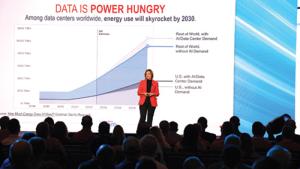Itron
Marina Donovan is Vice President of Global Marketing, ESG and Public Affairs at Itron.
Itron recently released its "2024 Itron Resourcefulness Insight Report," as part of its decade-long research in understanding the perspectives of utility executives and other stakeholders on issues surrounding how energy and water are delivered and used. The topic is an important one, "Exploring AI for Utilities; The Promise and Challenges of Artificial Intelligence."

The report examined the impact of artificial intelligence and machine learning, plus distributed or edge intelligence, among utility executives in six countries: Australia, Canada, France, India, the United Kingdom, and the United States. The findings on the impact of the promise and the challenges of artificial intelligence were explored in the January and March issues of this year's Public Utilities Fortnightly.
In this third and last look at Itron's timely report, Marina Donovan, Itron VP Global Marketing, ESG and Public Affairs discussed the barriers to AI adoption by utilities. There is much to learn here about the latest on AI and machine learning.
PUF's Steve Mitnick: Regarding Itron's Resourcefulness Insight Report, we're going to talk about barriers to AI adoption by utilities. What are those barriers?
 Itron’s Marina Donovan onstage in Palm Springs at the 2024 Inspire conference, delivering her keynote on the “2024 Itron Resourcefulness Insight Report” on artificial intelligence
Itron’s Marina Donovan onstage in Palm Springs at the 2024 Inspire conference, delivering her keynote on the “2024 Itron Resourcefulness Insight Report” on artificial intelligence
Marina Donovan: We surveyed utilities executives across six countries, but for the U.S. specifically, the number one barrier was the lack of expertise for artificial intelligence and machine learning, which was at forty-seven percent.
Number two was the high investment and integration costs of operationalizing AI, with forty-six percent of respondents citing cost as a roadblock. Again, this was utility executives speaking on the top barriers.
While they've acknowledged the workforce lacks the technical expertise to deploy AI and machine learning, they are looking at how to fix this through more training. About forty-eight percent of those surveyed said continuous training and education can help bridge that expertise gap, which makes a lot of sense.
The number one remedy is upscaling their own workforce. Number two is forming strategic partnerships, working with trusted technology partners, like Itron, that can help utilities enable AI and machine learning.
Number three is leveraging localized solutions. It's recognizing that every region has its own unique challenges. Then coming up with different strategies to address those local challenges, for the workforce in particular.
PUF: Talk about that a little bit more.
Marina Donovan: Utility size, structure, geography, and certainly regulatory environment all play a part. A muni or an IOU are going to look at and solve the problem differently. We're working with a muni customer who provides gas, water, and electricity. AI and ML are at different stages of maturity for these varied commodities.
This survey was done regarding primarily electricity, with just a bit of gas. But the opportunities for AI and machine learning, and the ability to use software and analytics, can help deal with all the challenges across commodities, and the technology is evolving rapidly.
Some of those challenges are things like aging infrastructure, which everybody has, and growing demand. In certain regions, like Las Vegas, the population is increasing so quickly. How do you deal with all that, meeting those needs?
Then you've got additional increases in demand from all of these massive data centers, as every single Google search you do takes a lot of energy and AI queries take even more energy. And all of that energy requires water, as well. So, demand is spiking across the board.
Then of course there's an increase in all these extreme weather events. Resiliency is key. You can't prevent the tornado from happening, but you certainly want to know who's been impacted, so you can get to those people first and get service restored quickly.
It's the same with the hurricanes, wildfires, floods and things like that, so you can take some preventative measures to help mitigate the losses and aid in recovery after an extreme weather event happens.
PUF: Can AI capabilities enhance that? How do they fold in?
Marina Donovan: Yes. A lot of it has to do with the data that's on the edge of the network. That was a big talking point for us at Distributech.
Because we're closest to the consumer, with devices at the very edge of the delivery network, leveraging sensors and computers on every device, we can give the utility better insights and intelligence about what's going on in the system without having to get a phone call of distress.
We can tell something's hot, such as a high impedance connection at a customer premise that could lead to a fire. We can monitor and identify when there's something happening with a transformer becoming overloaded that we need to look at.
Those are the common issues that happen with the influx of variable load from things like EVs. So, adding AI and ML to that greater visibility and control throughout the delivery network is really a game changer for utilities.
There're a lot of different solutions and ways to tie this technology in, but I want to try to stay on the point of the research itself. Back to the topic of education, there are a lot of trade organizations and others doing this training and helping to educate today's and tomorrow's workforce.
We provide a lot of STEM education to middle schoolers through our partnership with Discovery Education. We're trying to get the next generation of people excited about working in the energy and water industries, especially as a lot of people in it today are retiring.
PUF: How prepared do utilities feel for the AI revolution?
Marina Donovan: Twelve percent said their workforce is extremely prepared. When I asked people in the audience at Itron Inspire, I was surprised at how many people said they had AI or ML projects underway.
Sixty-five percent in this survey said they were prepared, and twenty-three percent said they were somewhat prepared for the AI revolution. So, while the survey showed that more education and training is certainly needed to prepare the workforce, our customers are already embracing AI-enabled programs.
It wasn't in the research, but my sense of them talking to customers is that they're excited about getting this convergence of data, analytics, and AI, and really this answer, so they can help address all these challenges. Everybody is excited about it. There seems to be a groundswell of movement toward that.
PUF: What do utilities need to do to overcome the barriers? Educating the workforce is one, but is that the main thing?
Marina Donovan: There are three things that came up in our research. The first was the need for proven technology, like please make sure that it works. Which makes sense for our industry and our role delivering critical infrastructure services.
Sixty-seven percent of respondents said we need to know that this technology, this solution, works. That was followed by regulatory support. Fifty-one percent said that's key. Next was employee education, as well as getting more policy clarification from federal and local governments.
Then in general, it's just peer engagement and sharing, which as we know is a hallmark of this industry, and an encouraging sign. That's what they said they need to help overcome the barriers to AI adoption.
PUF: When it comes to AI, where are utilities planning to invest, and spend money, capital, but also O&M dollars?
Marina Donovan: Here are the top three, and this goes with the previous data. One was training and getting data input for models, which was sixty-two percent.
Number two was improving the data quality of what we collect and leverage today. So, improving data quality and inadequacies in data sets was fifty-six percent.
Then addressing data latency and getting us closer to real-time data was at fifty-five percent. Because even though today's sensors can collect information in near-real time, having that information in the right place at the right time isn't always a given, depending on how things are set up.
There could be a delay, and even minor delays can present a different picture than what's happening on the grid. The more real-time our data is, the better.
PUF: Itron's Resourcefulness Insight Report, of which AI is just part of it, is an annual report. Does that mean another one is coming up, even before you finish one year?
Marina Donovan: We're already in the planning phases for this next version. We are looking at taking a deeper dive into the AI topic, especially on some of these barriers. We will look at issues like regulatory support, and what the different policies will be at the federal and state levels.
Because a lot of utilities see the advantages of what can happen, but there's also a need to go faster. Anyway, we'll see. We'll be releasing it at Itron Inspire in October.
PUF: You'll do this in the latter part of this year, and again, it'll be international. Is it always the same six countries?
Marina Donovan: We switch it up every other year. I think this year we will do a deeper dive on AI and edge intelligence in the U.S., and then next year it'll most likely be another global perspective on an industry-shaping topic.
PUF: What's the most rewarding, interesting or fun part of the process in creating the Itron Resourcefulness Insight Report?
Marina Donovan: The most gratifying part of the process is when a customer tells me that the information was useful. There are a lot of commonalities, both in the challenges and the solutions to those challenges, across the industry.
When we can tap into a topic and provide information that helps a customer make a move to better serve their customers that is the beauty of our industry. Because our industry is so open to peer sharing, those types of insights and decisions can build momentum. That's the best and most rewarding part.
PUF: Can anybody get this report?
Marina Donovan: It's available on itron.com/resourcefulness.



